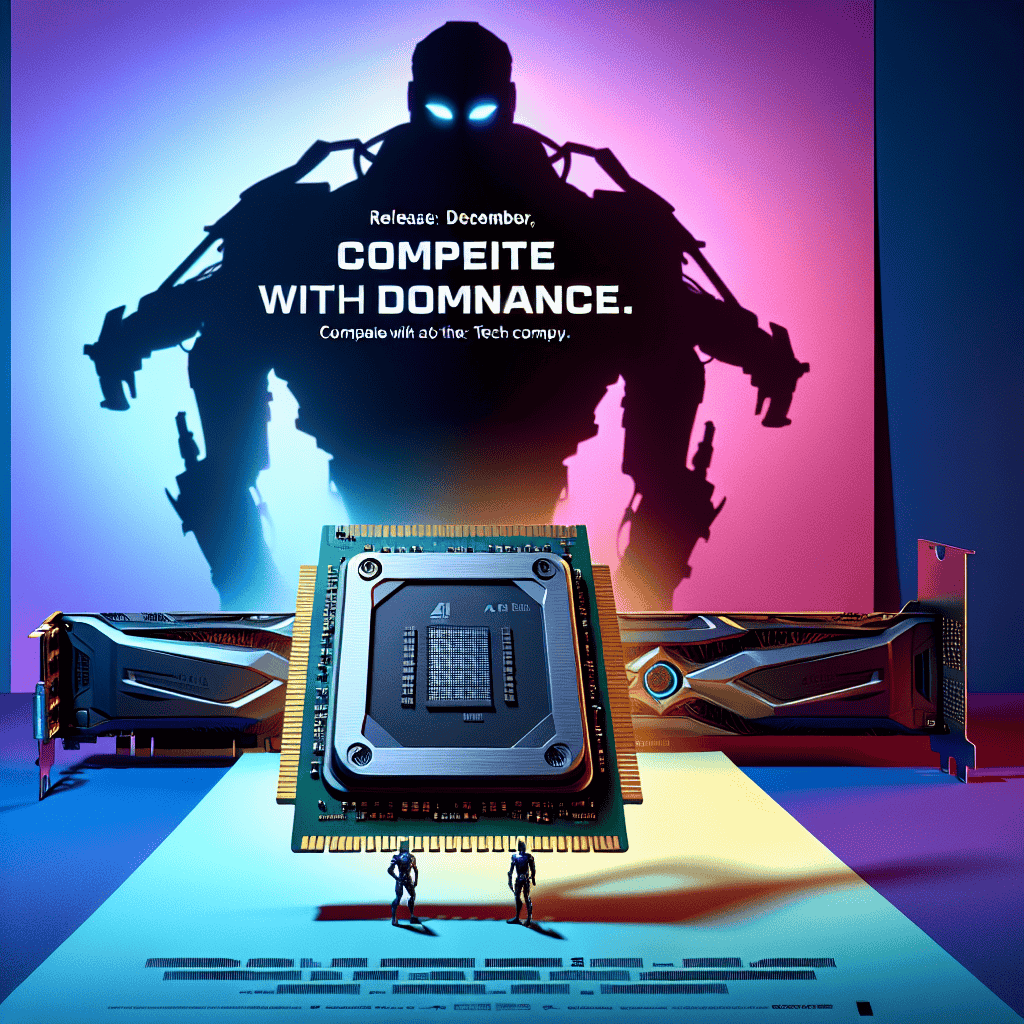“Amazon Enters the AI Arena: Challenging Nvidia with December Chip Debut”
Introduction
In December, Amazon is set to make a significant move in the technology sector by launching its own AI chips, aiming to challenge Nvidia’s stronghold in the market. This strategic initiative underscores Amazon’s commitment to expanding its influence in the artificial intelligence domain, leveraging its vast resources and technological expertise. By introducing these AI chips, Amazon seeks to provide a competitive alternative to Nvidia’s offerings, potentially reshaping the landscape of AI hardware. This development is poised to enhance Amazon’s cloud computing capabilities, offering customers more options and potentially driving down costs in the AI chip market. As the demand for AI-driven solutions continues to surge, Amazon’s entry into this space marks a pivotal moment in the ongoing evolution of AI technology.
Amazon’s Strategic Move: Launching AI Chips to Challenge Nvidia
In a bold strategic move, Amazon is set to launch its own line of artificial intelligence (AI) chips in December, aiming to challenge Nvidia’s current dominance in the AI hardware market. This development marks a significant step for Amazon as it seeks to expand its influence beyond its well-established cloud computing services and into the rapidly growing field of AI technology. The introduction of these AI chips is not only a testament to Amazon’s commitment to innovation but also a clear indication of its intent to diversify its technological portfolio and compete with industry giants.
The decision to enter the AI chip market comes at a time when the demand for AI capabilities is surging across various sectors, from autonomous vehicles to advanced data analytics. Nvidia has long been a leader in this space, with its graphics processing units (GPUs) being widely used for AI applications due to their high performance and efficiency. However, Amazon’s entry into this market could potentially disrupt Nvidia’s stronghold, offering customers an alternative that is deeply integrated with Amazon’s existing cloud infrastructure.
Amazon’s AI chips are expected to be optimized for machine learning tasks, providing enhanced performance for training and inference processes. By leveraging its vast experience in cloud computing, Amazon aims to offer a seamless integration of these chips with its Amazon Web Services (AWS) platform. This integration is likely to provide users with a more cohesive and efficient ecosystem for developing and deploying AI applications. Furthermore, Amazon’s extensive global network and customer base could facilitate rapid adoption of its AI chips, thereby accelerating its competitive stance against Nvidia.
In addition to performance considerations, cost-effectiveness is another critical factor that Amazon is likely to emphasize in its AI chip offerings. By potentially offering more affordable solutions, Amazon could attract a broader range of customers, including startups and smaller enterprises that may have previously found Nvidia’s offerings financially prohibitive. This strategy could democratize access to advanced AI capabilities, fostering innovation and growth across various industries.
Moreover, Amazon’s foray into AI hardware aligns with its broader strategic goals of enhancing its technological capabilities and maintaining its leadership position in the tech industry. By developing its own AI chips, Amazon can reduce its reliance on third-party suppliers, thereby gaining greater control over its supply chain and product development processes. This move could also lead to increased efficiency and cost savings, further strengthening Amazon’s competitive edge.
While the launch of Amazon’s AI chips is poised to create ripples in the industry, it is important to consider the challenges that lie ahead. Competing with an established player like Nvidia requires not only technological prowess but also a robust marketing strategy to convince potential customers of the benefits of switching to a new platform. Additionally, Amazon will need to ensure that its AI chips meet the high standards of reliability and performance that users have come to expect from Nvidia’s products.
In conclusion, Amazon’s decision to launch AI chips in December represents a significant milestone in its journey to expand its technological footprint and challenge Nvidia’s dominance in the AI hardware market. By leveraging its expertise in cloud computing and focusing on performance, cost-effectiveness, and integration, Amazon is well-positioned to make a substantial impact. As the launch date approaches, the tech industry will be watching closely to see how this development unfolds and what it means for the future of AI technology.
The Impact of Amazon’s AI Chips on the Tech Industry
In December, Amazon is set to unveil its new AI chips, marking a significant move in the tech industry as it seeks to challenge Nvidia’s longstanding dominance in the field. This development is poised to have far-reaching implications, not only for Amazon’s position in the market but also for the broader landscape of artificial intelligence and computing technology. As the demand for AI capabilities continues to surge across various sectors, the introduction of Amazon’s AI chips could potentially reshape the competitive dynamics within the industry.
To begin with, Amazon’s foray into AI chip manufacturing underscores its strategic intent to diversify its technological offerings and reduce reliance on third-party suppliers. By developing its own chips, Amazon aims to optimize the performance of its cloud computing services, particularly Amazon Web Services (AWS), which is a major revenue driver for the company. This move is expected to enhance AWS’s ability to deliver faster and more efficient AI processing capabilities, thereby attracting a wider range of customers seeking advanced computational power. Consequently, this could lead to increased competition among cloud service providers, prompting them to innovate and improve their own offerings.
Moreover, the introduction of Amazon’s AI chips is likely to intensify the competition with Nvidia, a company that has been at the forefront of AI hardware development. Nvidia’s graphics processing units (GPUs) have become the industry standard for AI workloads, thanks to their exceptional performance and versatility. However, Amazon’s entry into this space could disrupt Nvidia’s market share, especially if Amazon’s chips prove to be more cost-effective or offer superior performance. This potential shift in market dynamics could drive Nvidia to accelerate its own innovation efforts, leading to a faster pace of technological advancements in AI hardware.
In addition to impacting the competitive landscape, Amazon’s AI chips could also influence the development of AI applications across various industries. As businesses increasingly integrate AI into their operations, the availability of more powerful and efficient chips could enable the creation of more sophisticated AI models and applications. This, in turn, could lead to breakthroughs in fields such as healthcare, finance, and autonomous vehicles, where AI is already playing a transformative role. By providing the necessary computational power, Amazon’s chips could facilitate the development of AI solutions that are more accurate, reliable, and capable of handling complex tasks.
Furthermore, the launch of Amazon’s AI chips highlights the growing importance of hardware innovation in the AI ecosystem. While much of the focus in AI development has traditionally been on software and algorithms, the performance of AI systems is increasingly dependent on the underlying hardware. As such, advancements in chip technology are crucial for unlocking the full potential of AI. Amazon’s entry into the AI chip market underscores the need for continued investment in hardware research and development, as companies seek to push the boundaries of what AI can achieve.
In conclusion, Amazon’s upcoming launch of AI chips represents a pivotal moment in the tech industry, with the potential to reshape competitive dynamics, drive innovation, and accelerate the development of AI applications. As the industry eagerly anticipates the impact of these new chips, it is clear that Amazon’s move will have significant implications for the future of AI and computing technology. By challenging Nvidia’s dominance and advancing hardware capabilities, Amazon is poised to play a key role in shaping the next generation of AI solutions.
How Amazon’s AI Chips Could Redefine Cloud Computing
In the rapidly evolving landscape of cloud computing, Amazon’s announcement to launch its own AI chips in December marks a significant milestone that could potentially redefine the industry. As the demand for artificial intelligence and machine learning capabilities continues to surge, the need for more efficient and powerful hardware becomes increasingly critical. Amazon’s entry into the AI chip market is not just a strategic move to enhance its own cloud services but also a direct challenge to Nvidia’s current dominance in this space.
Nvidia has long been the leader in providing high-performance GPUs that power AI applications, making it a staple in data centers worldwide. However, Amazon’s foray into developing its own AI chips signifies a shift towards greater competition and innovation. By designing chips tailored specifically for its cloud infrastructure, Amazon aims to optimize performance and cost-efficiency, offering its customers enhanced capabilities for AI workloads. This move is expected to provide Amazon Web Services (AWS) with a competitive edge, potentially attracting a broader range of clients seeking specialized AI solutions.
Moreover, Amazon’s AI chips are anticipated to integrate seamlessly with its existing cloud ecosystem, providing users with a more cohesive and streamlined experience. This integration could lead to improved processing speeds and reduced latency, which are crucial for real-time AI applications. As a result, businesses leveraging AWS for their AI needs might experience significant improvements in operational efficiency and productivity. Furthermore, by controlling the entire stack—from hardware to software—Amazon can offer more customized solutions, catering to the specific needs of different industries.
In addition to enhancing its cloud services, Amazon’s development of AI chips underscores a broader trend in the tech industry: the move towards vertical integration. By investing in its own hardware, Amazon is not only reducing its reliance on third-party suppliers like Nvidia but also gaining greater control over its supply chain. This strategic shift could lead to cost savings and increased flexibility in adapting to market demands. Additionally, it positions Amazon to better navigate potential disruptions in the semiconductor industry, which has faced significant challenges in recent years.
While Amazon’s entry into the AI chip market is poised to disrupt the status quo, it also raises questions about the future of competition and innovation in the tech industry. As more companies develop proprietary hardware solutions, the landscape could become increasingly fragmented, with each provider offering distinct advantages and limitations. This scenario might lead to a more diverse range of options for consumers, but it could also complicate interoperability and standardization efforts.
Nevertheless, Amazon’s initiative is likely to spur further advancements in AI technology, as competitors strive to keep pace with the new developments. This competitive pressure could accelerate innovation, leading to more powerful and efficient AI solutions that benefit businesses and consumers alike. As the December launch approaches, industry observers will be keenly watching how Amazon’s AI chips perform in real-world applications and how they impact the broader cloud computing market.
In conclusion, Amazon’s decision to launch AI chips represents a bold step towards reshaping the cloud computing landscape. By challenging Nvidia’s dominance and pursuing vertical integration, Amazon is positioning itself as a formidable player in the AI hardware arena. As the industry continues to evolve, the introduction of these chips could herald a new era of innovation and competition, ultimately driving progress and delivering enhanced capabilities to users worldwide.
Comparing Amazon’s AI Chips with Nvidia’s Offerings

In the rapidly evolving landscape of artificial intelligence, the competition to develop more efficient and powerful hardware is intensifying. Amazon’s announcement of its plan to launch AI chips in December marks a significant step in this competitive arena, particularly as it seeks to challenge Nvidia’s long-standing dominance. As the tech giant prepares to introduce its new AI chips, a comparison with Nvidia’s offerings becomes inevitable, given Nvidia’s established reputation for producing high-performance graphics processing units (GPUs) that have become the backbone of AI computations.
Amazon’s entry into the AI chip market is not entirely unexpected, considering its substantial investments in cloud computing and machine learning through its Amazon Web Services (AWS) platform. The introduction of these AI chips is poised to enhance AWS’s capabilities, offering customers more tailored and efficient solutions for their AI workloads. In contrast, Nvidia has been a pioneer in the field, with its GPUs widely recognized for their ability to handle complex AI tasks, such as deep learning and neural network training. Nvidia’s GPUs have set a high benchmark, known for their speed, efficiency, and versatility, which have made them the preferred choice for many AI researchers and developers.
One of the key aspects of Amazon’s AI chips is their potential integration with AWS, which could provide a seamless experience for users already embedded in Amazon’s ecosystem. This integration could offer significant advantages in terms of cost-effectiveness and ease of use, as customers might benefit from optimized performance without the need for additional hardware investments. On the other hand, Nvidia’s GPUs are renowned for their compatibility across various platforms and their ability to support a wide range of AI applications, from autonomous vehicles to healthcare diagnostics. This versatility has been a cornerstone of Nvidia’s success, allowing it to maintain a stronghold in the AI hardware market.
Moreover, Amazon’s AI chips are expected to leverage the company’s expertise in custom silicon design, which has been demonstrated through its Graviton processors. This expertise could translate into chips that are highly specialized for specific AI tasks, potentially offering performance improvements over general-purpose GPUs. However, Nvidia’s continuous innovation in GPU architecture, such as the introduction of its Ampere and Hopper architectures, has consistently pushed the boundaries of what is possible in AI processing. These advancements have enabled Nvidia to deliver unparalleled performance and efficiency, setting a high standard for any new entrants in the market.
Furthermore, the competition between Amazon and Nvidia is likely to drive advancements in AI chip technology, benefiting the broader industry. As Amazon seeks to carve out its niche, it may focus on optimizing its chips for specific use cases, such as natural language processing or computer vision, where AWS already has a strong presence. Meanwhile, Nvidia’s established ecosystem, including its CUDA platform and extensive developer support, provides a robust foundation for continued innovation and adoption.
In conclusion, Amazon’s forthcoming AI chips represent a bold move to challenge Nvidia’s dominance in the AI hardware market. While Amazon brings its strengths in cloud integration and custom silicon design, Nvidia’s established reputation and continuous innovation present formidable competition. As both companies strive to outpace each other, the resulting technological advancements are likely to propel the AI industry forward, offering new possibilities and efficiencies for businesses and researchers alike. The coming months will reveal how Amazon’s new offerings stack up against Nvidia’s, potentially reshaping the landscape of AI hardware.
The Role of AI Chips in Amazon’s Future Growth
Amazon’s announcement to launch its own AI chips in December marks a significant strategic move aimed at challenging Nvidia’s dominance in the artificial intelligence hardware market. As the demand for AI-driven solutions continues to surge, the role of AI chips in Amazon’s future growth cannot be overstated. These chips are designed to enhance the efficiency and performance of AI applications, which are increasingly integral to Amazon’s vast ecosystem, including its cloud computing services, e-commerce platform, and smart devices.
The development of proprietary AI chips is a logical step for Amazon, given the company’s extensive investment in artificial intelligence technologies. By creating its own chips, Amazon aims to optimize the performance of its AI workloads, reduce dependency on third-party suppliers, and potentially lower costs. This move is particularly significant in the context of Amazon Web Services (AWS), the company’s highly profitable cloud computing division. AWS has been a key driver of Amazon’s growth, and the integration of custom AI chips could further solidify its position as a leader in the cloud market.
Moreover, the introduction of Amazon’s AI chips is expected to enhance the capabilities of its AI-powered services, such as Alexa, the company’s voice-activated virtual assistant. By leveraging these chips, Amazon can improve the speed and accuracy of Alexa’s responses, thereby enhancing user experience and maintaining its competitive edge in the smart home market. Additionally, these chips could play a crucial role in Amazon’s logistics and supply chain operations, where AI is used to optimize inventory management, predict demand, and streamline delivery processes.
Transitioning from reliance on Nvidia’s GPUs to its own AI chips also aligns with Amazon’s broader strategy of vertical integration. By controlling more aspects of its technology stack, Amazon can better tailor its solutions to meet specific business needs and customer demands. This approach not only fosters innovation but also provides Amazon with greater flexibility in adapting to rapidly changing technological landscapes.
Furthermore, the launch of AI chips underscores Amazon’s commitment to sustainability. Custom-designed chips can be more energy-efficient than general-purpose processors, which is a critical consideration as data centers consume increasing amounts of power. By reducing energy consumption, Amazon can lower operational costs and contribute to its sustainability goals, which include achieving net-zero carbon emissions by 2040.
In addition to these strategic benefits, Amazon’s entry into the AI chip market could have broader implications for the industry. It introduces a new competitor to a market that has been largely dominated by Nvidia, potentially driving innovation and leading to more diverse offerings for consumers. This competition could also result in more competitive pricing, making AI technologies more accessible to a wider range of businesses and developers.
In conclusion, Amazon’s decision to launch AI chips in December is a pivotal development that could significantly impact its future growth. By enhancing the performance of its AI applications, reducing costs, and promoting sustainability, these chips are poised to play a crucial role in Amazon’s strategy. As the company continues to expand its influence across various sectors, the successful integration of AI chips will be instrumental in maintaining its competitive advantage and driving innovation in the rapidly evolving technology landscape.
Potential Benefits for AWS Users with Amazon’s New AI Chips
In December, Amazon is set to introduce its new AI chips, marking a significant move to challenge Nvidia’s stronghold in the artificial intelligence hardware market. This development is particularly noteworthy for users of Amazon Web Services (AWS), as it promises to bring a host of potential benefits. As the demand for AI-driven solutions continues to surge, the introduction of Amazon’s AI chips could offer AWS users enhanced performance, cost efficiency, and greater flexibility in deploying AI applications.
To begin with, one of the most compelling advantages of Amazon’s new AI chips is the potential for improved performance. These chips are designed to handle complex AI workloads more efficiently, which could translate into faster processing times and more robust capabilities for AWS users. By leveraging Amazon’s AI chips, businesses can expect to accelerate their AI and machine learning tasks, thereby gaining a competitive edge in their respective industries. This is particularly crucial for sectors that rely heavily on real-time data processing and analysis, such as finance, healthcare, and e-commerce.
Moreover, the introduction of Amazon’s AI chips could lead to significant cost savings for AWS users. Traditionally, AI workloads have required substantial computational power, often resulting in high operational costs. However, Amazon’s chips are expected to offer a more cost-effective solution by optimizing energy consumption and reducing the need for expensive hardware. This could make AI technologies more accessible to a broader range of businesses, including small and medium-sized enterprises that may have previously found the costs prohibitive. Consequently, this democratization of AI technology could spur innovation and drive growth across various sectors.
In addition to performance and cost benefits, Amazon’s AI chips are likely to provide AWS users with greater flexibility in deploying AI applications. With these chips, users can tailor their AI infrastructure to better meet their specific needs, whether that involves scaling up to handle increased demand or customizing solutions for niche applications. This flexibility is particularly valuable in today’s rapidly evolving technological landscape, where businesses must be agile and responsive to changing market conditions. By offering a more adaptable AI infrastructure, Amazon empowers its users to innovate and experiment with new ideas without being constrained by hardware limitations.
Furthermore, the launch of Amazon’s AI chips could foster a more competitive landscape in the AI hardware market. Nvidia has long been the dominant player in this space, but Amazon’s entry could stimulate further advancements and drive down prices, ultimately benefiting consumers. As competition intensifies, AWS users can expect to see continued improvements in AI chip technology, leading to even greater performance and efficiency gains in the future.
In conclusion, the impending launch of Amazon’s AI chips in December represents a significant development for AWS users. By offering enhanced performance, cost efficiency, and flexibility, these chips have the potential to transform how businesses deploy and utilize AI technologies. As the AI hardware market becomes more competitive, AWS users stand to benefit from ongoing innovations and improvements, positioning them to thrive in an increasingly AI-driven world. With these advancements, Amazon is not only challenging Nvidia’s dominance but also paving the way for a new era of AI accessibility and innovation.
Market Reactions to Amazon’s Entry into the AI Chip Arena
In a significant move that has captured the attention of the tech industry, Amazon is set to launch its own AI chips in December, marking a bold entry into a market currently dominated by Nvidia. This strategic decision by Amazon is not only a testament to the growing importance of artificial intelligence in various sectors but also highlights the competitive landscape of the semiconductor industry. As Amazon prepares to unveil its AI chips, market reactions have been swift and varied, reflecting both optimism and skepticism about the potential impact on Nvidia’s stronghold.
The announcement has undoubtedly stirred excitement among investors and industry analysts, who are keenly observing how Amazon’s entry might reshape the competitive dynamics. Amazon’s foray into AI chips is seen as a natural extension of its cloud computing services, particularly Amazon Web Services (AWS), which has been a significant growth driver for the company. By developing its own AI chips, Amazon aims to enhance the performance and efficiency of its cloud services, offering customers more tailored and cost-effective solutions. This move is expected to attract businesses seeking to leverage AI capabilities without the hefty price tag associated with Nvidia’s offerings.
However, the market’s reaction is not solely based on enthusiasm. There is a palpable sense of caution as stakeholders consider the challenges Amazon might face in this highly specialized field. Nvidia has long been the leader in AI chip technology, with a well-established ecosystem and a reputation for cutting-edge innovation. The company’s dominance is built on years of research and development, resulting in a suite of products that are widely regarded as the gold standard in AI processing. Consequently, Amazon’s entry is perceived as a formidable challenge, requiring significant investment in research, talent acquisition, and strategic partnerships to compete effectively.
Moreover, the timing of Amazon’s launch is critical. The demand for AI chips is surging, driven by advancements in machine learning, data analytics, and autonomous systems. This growing demand presents a lucrative opportunity for Amazon to capture market share. Yet, it also means that the company must deliver a product that not only matches but potentially exceeds the capabilities of existing solutions. The pressure to innovate and differentiate its offerings will be immense, as Amazon seeks to convince customers of the value proposition of its AI chips.
In addition to the technical and market challenges, Amazon’s entry into the AI chip arena raises questions about the broader implications for the semiconductor industry. The introduction of a new player of Amazon’s stature could lead to increased competition, driving innovation and potentially lowering prices. This could benefit consumers and businesses alike, fostering a more dynamic and accessible AI ecosystem. However, it may also intensify the race for technological supremacy, prompting existing players to accelerate their own development efforts to maintain their competitive edge.
As December approaches, all eyes will be on Amazon to see how its AI chips perform and how the market responds. The company’s ability to navigate the complexities of this competitive landscape will be crucial in determining its success. While the road ahead is fraught with challenges, Amazon’s entry into the AI chip market represents a significant development with the potential to reshape the industry. As such, the coming months will be pivotal in assessing the long-term impact of this ambitious endeavor on both Amazon and the broader tech ecosystem.
Q&A
1. **What is Amazon planning to launch in December?**
Amazon is planning to launch AI chips.
2. **What is the purpose of Amazon’s AI chips?**
The purpose is to compete with Nvidia’s dominance in the AI chip market.
3. **When is Amazon expected to launch these AI chips?**
Amazon is expected to launch these AI chips in December.
4. **Who is Amazon’s main competitor in the AI chip market?**
Nvidia is Amazon’s main competitor in the AI chip market.
5. **Why is Amazon entering the AI chip market?**
Amazon is entering the AI chip market to challenge Nvidia’s market dominance and potentially offer more options for AI processing.
6. **What industry will Amazon’s AI chips impact?**
Amazon’s AI chips will impact the artificial intelligence and cloud computing industries.
7. **How might Amazon’s entry into the AI chip market affect Nvidia?**
Amazon’s entry could increase competition, potentially affecting Nvidia’s market share and pricing strategies.
Conclusion
Amazon’s decision to launch AI chips in December marks a strategic move to challenge Nvidia’s dominance in the AI hardware market. By entering this competitive space, Amazon aims to leverage its vast resources and technological expertise to offer an alternative to Nvidia’s widely used GPUs. This initiative could potentially drive innovation, reduce costs, and provide more options for businesses and developers seeking AI solutions. If successful, Amazon’s entry could disrupt the current market dynamics, fostering increased competition and accelerating advancements in AI technology.




